Kategori: Okategoriserade
Extraphonic

Extraphonic, an interactive link between Joubert Park, Johannesburg
1-2pm
Saturdays and Sundays
Joubert park
Umeå Public Bath
Extraphonic is initiated by Elin Wikstrom and Cecilia Parsberg, Sweden and is part of the Joubert Park Public Art Project 13th October to end of December 2001.
Extraphonic is a series of ongoing exchanges between two networks, one in South Africa and one in Sweden. At the same date and time, 12 persons from different locations and life situations, talk to each other on the phone. In Johannesburg the event takes place in Joubert Park, in Umea it’s winter so people meet at the Public Bath.
Extraphonic sets up an active link between the park, the public bath and local radio. Parts of the conversations will be broadcasted regularly. Bengt Strom, Vasterbotten Radio, Sweden will make weekly reports. It’s possible for people who listen to the local radio stations to call in to the Extraphonic events.
From mid-October to end of December the networks will expand. At the end 200 persons have been involved. The method is to invite 6 people in Johannesburg and 6 in Umea, they visit Extraphonic togheter with a friend. Each participator will either put a question to a person in the other network or answer one. At the next event it is instead the friend who is the one speaking on the phone and inviting a new person to the network. Since all participators (except at the first event) have attended one event before, they have had time to think about what they want to ask. But it can also happen that the first question will trigger a subject that everybody wants to know more about. Both in the park and at the indoor swimmingpool, the telephones are connected to loudspeakers so that visitors will be able to hear the conversations. It is about listening and speaking to each other, not just in the small group that one belongs to but to people one usually doesn’t socialize with.

Extraphonic 1 October 20 Extraphonic 2 October 21
Extraphonic 3 October 27 Extraphonic 4 October 28
Extraphonic 5 November 3 Extraphonic 6 November 4
Extraphonic 7 November 10 Extraphonic 8 November 11
Extraphonic 9 November 17 Extraphonic 10 November 18
Extraphonic 11 November 24 Extraphonic 12 November 25
Extraphonic 13 December 1 Extraphonic 14 December 2
Extraphonic 15 December 8 Extraphonic 16 December 9
Welcome!
Cecilia Parsberg and Elin Wikstrom, oct. 2001
Ceciliaparsberg@yahoo.com +46 (0)70 3966661 (telephone no. in RSA)
Elinhoo@yahoo.com 072-2200559 +46 (0)70 6714858
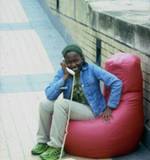
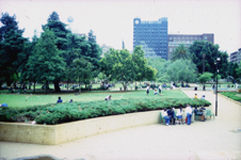

The Voice
An action initiated by Cecilia Parsberg, Sweden and Madoda Floyd ‘Fly’ Msibi, South Africa. Start: year of 2000 with a video-tale, 35 photos in 2001, and an interactive web site 2002- 2003. Platform: Stockholm-Soweto-Reykjavik
 People involved:
People involved:
Idea and process: Cecilia Parsberg and Madoda Fly Msibi
Video editor: Cecilia Parsberg and Menno Boerema
Photos: Cecilia Parsberg
Camera: Madoda Fly Msibi, Cecilia Parsberg and Katja Aglert.
Web site: Web designer:Mats Renvall, The screen saver: Thomas Broomé
Travel organisation for Island: Ana L Valdés
Description: The art project vo-ice includes three parts. It follows a purchased diamond, called ice, in South Africa. Cecilia lived in Soweto a month, she and Madoda searched for a diamond, they found one. Cecilia took the diamond with her to Sweden and six months later Fly came and lived in Stockholm for a month. They went with the diamond to Iceland, dropped it in the water there and the ice turned into voices. On www.this.is/Parsberg/ice the third part of the site, was possible for people to tell their stories. If you downloaded a screen saver the stories would automatically be displayed as soon as they were written ”cyberspace does not exist as a space; it can, however, exist as soon as one acts. This is communication”

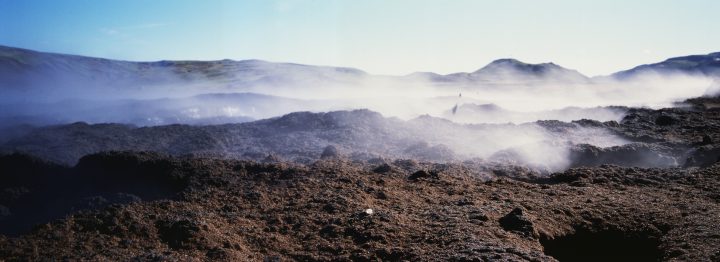

Cecilia Parsberg is the initiator of several projects working in the realms of art and activism, post colonial theory, globalisation and representation, using the Internet as a forum for publication, information and a way of connecting to people.
Madoda Floyd Msibi is selling artefacts in Soweto. He is developing ways of living and acting in Soweto and through this discussing the future of this society. He is interested in art and activism, post colonial theory, globalisation and representation.
Fly: – ‘Cecilia, Do you believe the trees are breathing?’
Cecilia: – ‘Yes.’
Fly: – ‘Then, there’s no place that’s a non-place. Because you can chase someone in the bush and you think someone is not watching you but the very trees and grass are watching you and the soil as well, because they’re breathing. So, there’s no place in reality that’s a non-place. If you believe in a material world there is a non-place but if you believe in the spiritual world there is no place that’s a non-place.
vo-ice became a growing network of people. When diamonds have crossed borders it has not been agreed with everyone involved, there are no bridges over these gaps. The action ICE was a bridge for a time.
Some participate in vo-ice by buying a photo of the diamond. There are 35 of them, all different, ice on ice or ice in fire. `When someone buys a piece of art they buy something to believe in, they look at it every day and there’s a real commitment on the purchaser’s part. With this work they can follow the whole process, they get the video-tale with the photo and the continuation with voices – stories by people, on the web site.
Hakhim Bey: – `No one willingly risks life in the NGZ* for mere ideology – but the utility of certain utopian models can be tested´. *No Go Zones
Marc Augé: – `In non-places the individual enters into a kind of pure relation with the forces of capital, unhindered by an attachment to community or identity. The non-place is designed to accommodate all people, regardless of age, place of birth, ethnicity, etc. It is a space void of particularity.´
Ana L Valdes: – `Non-places are the crack between memory and speech, the gap to our consciousness, the lost link to our past. Non-places are immersed in the geography of the possible.
Hakim Bey: – `If we study this embryonic or ontogenic map, we can see clearly that the ”South” has already been cut out of the pattern, by an act of cartomanic imperialism that denies meaning to the same areas which have been denied ”access” to the Commlinks. The South will reenter the paradise of information – for information is glacial crystalline ice, while the South is the realm of fire and noise.´
Cecilia Parsberg: ‘I am not satisfied with the fact that I can only communicate with a limited number of artists in the world – that my exchange and interaction with others, both as a human being and as an artist, is regulated by economical reasons. The limitation in the economy for everyone becomes our limitation of knowledge because we don’t have access to what others might give or say.
Luce Irigaray: – `Dialogue between two resists totalitarianism´
To all queens

Video cover with stills from the video
To All Queens, is the name of an installation and a series of film seminars. Produced in May 2000.
I call the whole project an action. It was filmed and photographed 17/05 2000 in Cape Town, South Africa.
On the 14th of September 2000, the video To All Queens and a letter were sent to all royal Queens in the world. The action was published in the Swedish magazine OOTAL #2/3, 2000. Eight of the royal Queens answered my letter and these letters are also a part of the installation. The video is only shown in scheduled public seminars held by the artist.
The installation To All Queens consists of:
– An un-edited video To All Queens (see video cover above)
– The letter sent to each royal Queen in the world and the reply letters from the royal Queens – 8 out of 12 replied.
– A photo of District Six, where I met the Queen of homeless. (C-Print 2X1 m. see below) and info about District Six.
– A photo of The Queen of Homeless with King and friends (C-Print 2X1 m. see below)
The Letter
Stockholm, September 2000
Her Majesty Queen…
Queen of the Kingdom of …
Your Royal Highness
My name is Cecilia Parsberg, I grew up in Sweden. I live and work as a visual artist in London. During May and June, 2000 I travelled around South Africa. When I visited an area in the centre of Cape Town called District Six I met a woman. She came up and started to talk to me and my videocamera about her situation, being homeless, She said: I am the Queen of Homeless. Me, my King and my friends don’t have a house, we don’t have a shelter, I don’t even have ID. I am speaking for all homeless people and to you as a woman to a woman. Please tell them…
I told her that I work as an artist and I said to her that I would do what I can.
She saw my camera as a medium and a possibility. I filmed and photographed her, her husband and her friends. Many of us are born into a life situation that steers our destiny and this is usually the main obstacle for each individual in the search to find freedom. As an artist I make and intermediate images of what I percieve living in the society. I am sending this video to you and to all the Queens in the world. This video is her possibility to meet you and yours to meet her. Please find enclosed a videocasette with the title: ”To all Queens” as a gift.
This letter will be published in the Swedish art- and litterature- magazine ”OOTAL” together with some stills from the video and and a list of all the Queens it has been sent to. The video will exclusively be shown to the Queens and in my lectures.
You can find out more about the magazine on: http://www.OOtal.com
If you want to know more about District Six where Queen of Homeless is staying you can find some information on: http://www.districtsix.co.za/text/archteap.htm
If you would like to find out more about my work you can find it under: http:/www.umu.se/art/parsberg
Sincerely
Cecilia Parsberg
Work address: Guest Professor, Academy of Fine Arts
Umea University
S-901 87 UMEA
SWEDEN
ceciliaparsberg@yahoo.com
Homepage:http://www.umu.se/art
mobile: +46 (0)70 3286819

The Queen of Homeless with King and friends
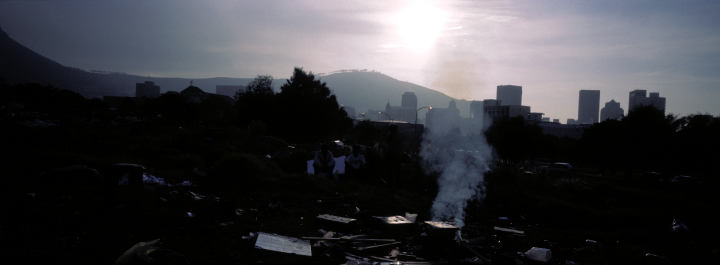
District Six
is the name of a former inner-city residential area in Cape Town, South Africa. Over 60,000 of its inhabitants were forcibly removed during the 1970s by the apartheid regime. On 11 February 1966, the government declared District Six a whites-only area under the Group Areas Act, with removals starting in 1968. By 1982, more than 60,000 people had been relocated to Cape Flats township complex some 25 kilometres away. The old houses were bulldozed. (see also http://www.districtsix.co.za/)
List of all legal queens
| Her Majesty Queen Noor Queen of the Kingdom of JordanThe Royal PalaceAmmanJORDAN |
Her Majesty Queen Aishwarya Queen of the Kingdom of NepalThe Royal PalaceKatmanduNEPAL |
| Her Majesty Empress Michiko Empress of JapanThe Royal PalaceKyotoJAPAN |
Her Majesty Queen Beatrix Queen of the Kingdom of the NetherlandsThe Royal PalaceHaagTHE NETHERLANDS |
| Her Majesty Queen Margrethe IIQueen of the Kingdom of DenmarkThe Royal PalaceKobenhavnDENMARK | Her Majesty Queen Sonja Queen of the Kingdom of NorwayThe Royal PalaceOsloNORWAY |
| Her Majesty Queen Paola Queen of the Kingdom of BelgiumThe Royal PalaceBrusselsBELGIUM |
Her Majesty Queen Sophia Queen of the Kingdom of SpainThe Royal PalaceMadridSPAIN |
| Her Majesty Queen Silvia Queen of the Kingdom of SwedenThe Royal PalaceStockholmSWEDEN |
Her Majesty Queen Mom Rajawongse Sirikit Queen of the Kingdom of ThailandThe Royal PalaceBangkokTHAILAND |
| Her Majesty Queen Elisabeth II Queen of the United Kingdom ofGreat Britain and Northern IrelandThe Royal PalaceLondonGREAT BRITAIN |
Her Majesty Queen Halaevalu Mata’aho’Ahom’e The Royal Palace Nuku’alofa TONGA |
Postcards of South Africa

The cover of the postcard packet (23 X 9cm) A shack is usually made of corrugated iron covering a wooden structure.
R= Rand, 1 Rand=10p
![]()
Postcards of South Africa, A collaborative work between artists in, Soweto, Johannesburg Wit’s university, South Africa and me Cecilia Parsberg, Umeå Art Academy, Sweden, in 2000.
Included in the packets of postcards are six photographs; The White House (as it is commonly called), located in Orlando West, Soweto, has served past and present as a meeting place for people involved in the struggle against apartheid. The blue house and Black and Red shacks are located in Alexandra, and the Green and Yellow shacks are located in Thokoza, completing The Colours of the new South African flag.
From January, 2001, the packets of postcards could be bought at the souvenir stall at Hector Petersen Square in Soweto. 3000 packets=18.000 postcards was printed. All of them were sold by 2004. These panorama photographs and collaborative project has been shared with the buyers and the postcards been sent around the world.
In January 2001 we also went back to every house and shack pictured on the postcards and handed over packets.
Background and process: In May, 2000, I, Cecilia Parsberg, visited Soweto. The following month some artists who lives in Soweto, guided me through different townships surrounding Johannesburg. The photographs were taken during these guided visits. We decided to display and sell the selected images at souvenir stalls in the townships where they were photographed.
For the majority of Johannesburg’s inhabitants home is in one of the black townships, surrounding the city.The townships have played a crucial role in the struggle against apartheid. Most white South Africans are ignorant of life in the townships, very few have ever been inside one. The situation is slowly changing, more and more visitors from all over the world come to the townships. They want to see the historical places and some of them also stay over night with a local family. Today there is a growing number of ”whities” living in Soweto, many of them has recently immigrated.
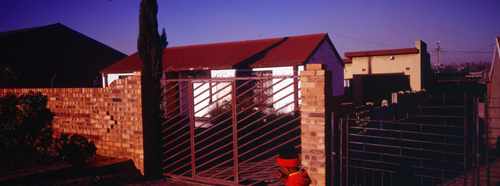
”THE WHITE HOUSE”
The photographs of the blue house, the black and red schacks are taken in Alexandra. It’s a huge very poor township and a part of Sandton City, a wealthy predominantly white ghetto outside Johannesburg. There are still no guided tours to Alexandra.
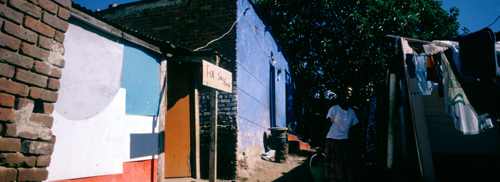


The green and yellow schacks are from Thokoza. This township was divided in areas for coloured indian and black people. It started as a township for black people, in the 70:s the government built houses for the coloureds and in the 90:s houses were built for indians.

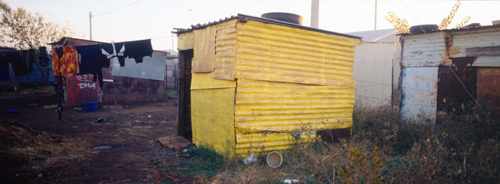
 Although South Africa has rejected racism, it still collects population statistics on the basis of race. In 2000: of the population of about 38 million, some 28 million are black, 5.6 million are white, 3.4 are coloured (ie.mixed race) and 1 million of Indian descent. South Africa’s economy is a mixture of First and Third World with a marked disparity in incomes, standards of living, lifestyles, education and work opportunities.
Although South Africa has rejected racism, it still collects population statistics on the basis of race. In 2000: of the population of about 38 million, some 28 million are black, 5.6 million are white, 3.4 are coloured (ie.mixed race) and 1 million of Indian descent. South Africa’s economy is a mixture of First and Third World with a marked disparity in incomes, standards of living, lifestyles, education and work opportunities.
This piece has been made possible through the SIDA project ”Cultures in Dialogue,” initiated and organized by Bild Museet, Umea, Sweden. I was at the time Guest Professor at Umea Academy of Fine Arts, and in this project I taught at the Fine Arts Department at Witwatersrand University, Johannesburg, South Africa, for two months (17 April through 1 June) when this was made and then returned several times.
This piece was exhibited at BildMuseet, Umea, Sweden. February 25 – May 1, 2001